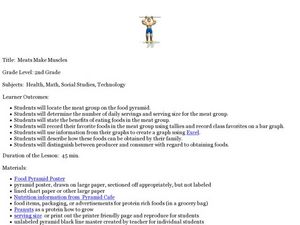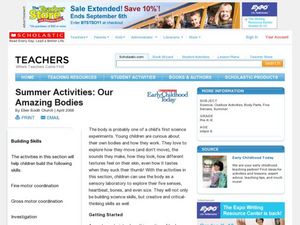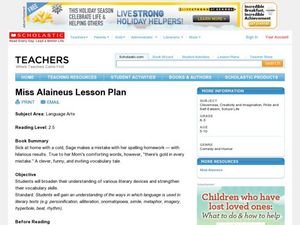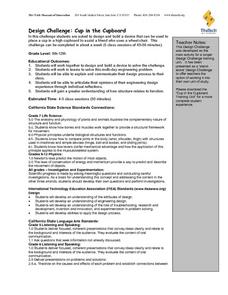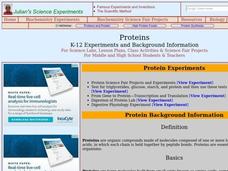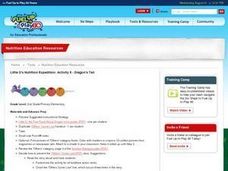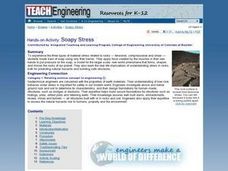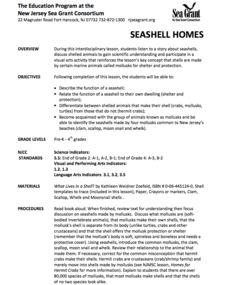Curated OER
Why Muscle Biology?
Students research and define a muscle biology research question and organize an experiment to address the question utilizing either NADH staining or acid buffering. They analyze data as well as draw conclusions about their research....
Curated OER
Meats Make Muscles
Second graders explore the meat group of the food pyramid. In this nutrition and diet lesson, 2nd graders study the benefits of eating foods in the meat group, collect data regarding their classmates' favorite foods, and create a graph...
BioEd Online
Good Stress for Your Body
Stress the importance of the different types of pressure our mind and body experience in a lesson about how certain types of stress are actually necessary and good for our bodies. As astronauts and people with injuries can attest, not...
Curated OER
MuscleMania
Middle schoolers learn three different types of muscles. By building a model of the arm, they learn its basic anatomy and how muscles function in relationship to bones. They perform an experiment on the relationship between muscle size...
Curated OER
An Arm and A Leg
Young scholars examine how the movements of bones are dependent on the interaction of pairs of muscles. They design and construct a prototype of an artificial limb using a syringe system, and determine whether water or air makes the...
Curated OER
Pollution and Lung Health
Young scholars investigate how pollution affects lung health. In this pollution and lung health lesson, students build lung models from a soda bottle and balloons, and then discuss how the emissions from fossil fuels can adversely affect...
Curated OER
The Magic School Bus Flexes Its Muscles
Students learn along with Ms. Frizzle's class. In this Magic School Bus lesson plan, students explore the inside of the human body as they compare the bones and joints of a chicken wing with their own hands and arms.
Curated OER
Anatomy and Physiology "Quickies"
Young scholars use a variety of creative writing tools within this assignment: poems on particular organ systems, write a short story and/or create a word graph. They are involved in a demonstration of lactic build up in the muscles, a...
Curated OER
Summer Activities: Our Amazing Bodies
Students use the body as a sensory laboratory to explore their five senses, heartbeat, bones, and even size. In this early childhood science lesson, students build science and critical thinking skills as they take part in up to 6...
Curated OER
Prosthetic Limbs
Students create a simple model of the muscles in hand opening and closing the it. They make the model move a block in a specified direction.
Curated OER
Enzyme Lab
Learners examine the effects of specific enzymes on samples of liver tissue, muscle tissue (chicken), apples, and potatoes.
Curated OER
Miss Alaineus Lesson Plan
Students gain an understanding of various literary devices and strengthen their vocabulary. In this Miss Alaineus lesson plan, students read the vocabulary tale, discuss the use of literary devices and choose from 4 possible culminating...
Curated OER
Pet Rescue
Young scholars, in teams, follow the process of design, including the stages of investigation, creation, and reflection, as they devise a way to help "save" a (simulated) pet who is trapped in a pipe.
PBS
Robo Arm
Future engineers create robotic arms like those on rovers built by NASA in the second instructional activity of the series. They test their devices by attempting to pick up and move cups to a specified location.
Curated OER
Nutrition and Fitness
Students explore nutrients found in foods. In this health lesson, students discuss the importance of a healthy diet and exercise. Students track the number of calories burned during various forms of exercise.
Curated OER
Design Challenge: Cup in the Cupboard
Students design device that will place a cup into a cupboard for a physically challenged person. They study the engineering design and how structure relates to function.
Curated OER
Proteins
Students conduct a variety of experiments to explore protein. In this biology lesson, students solve a mystery by testing for the presence of glucose, protein starch and triglycerides. They explain how DNA transcription and translation...
Curated OER
The Dragon's Tail
Second graders read a story about Little D, a baby dragon, and how he interacts with the five food groups. They color, chant, pantomime, and discuss food groups after reading the story. They also consider causes and effects as they make...
Curated OER
Soapy Stress
Students investigate the three types of material stress related to rocks. They identify the three types of stress, conduct a simulation by breaking bars of soap using only their hands, and complete a worksheet.
Curated OER
Vitamin C and Protein Analysis
Students analyze various beverages to determine vitamin C content. Students research diseases resulting from vitamin C deficiencies and identify countries most affected.
Curated OER
The Shape of Things
Sixth graders read and discuss information regarding the shape and attributes of an eggshell. In this shape of things lesson plan, 6th graders gather relevant information that pertains to the incubation and formation of an...
Curated OER
Seashell Homes
Pupils listen to a story about seashells. They discuss shelled animals. Learners describe the function of seashell. Pupils relate the function of a seashell to their own dwelling. They differentiate between shelled animals that make...
Curated OER
Meat, Poultry, Fish, Eggs: Constructing and Maintaining
Students investigate meat as a source that provides protein, iron and nutrients in the diet. They identify types of meat and their sources, complete a market survey, conduct a fried egg experiment, and prepare various recipes that...
Curated OER
A Cell Is Like A City
Students create analogies that help them remember the cell parts as well as their respective functions.

